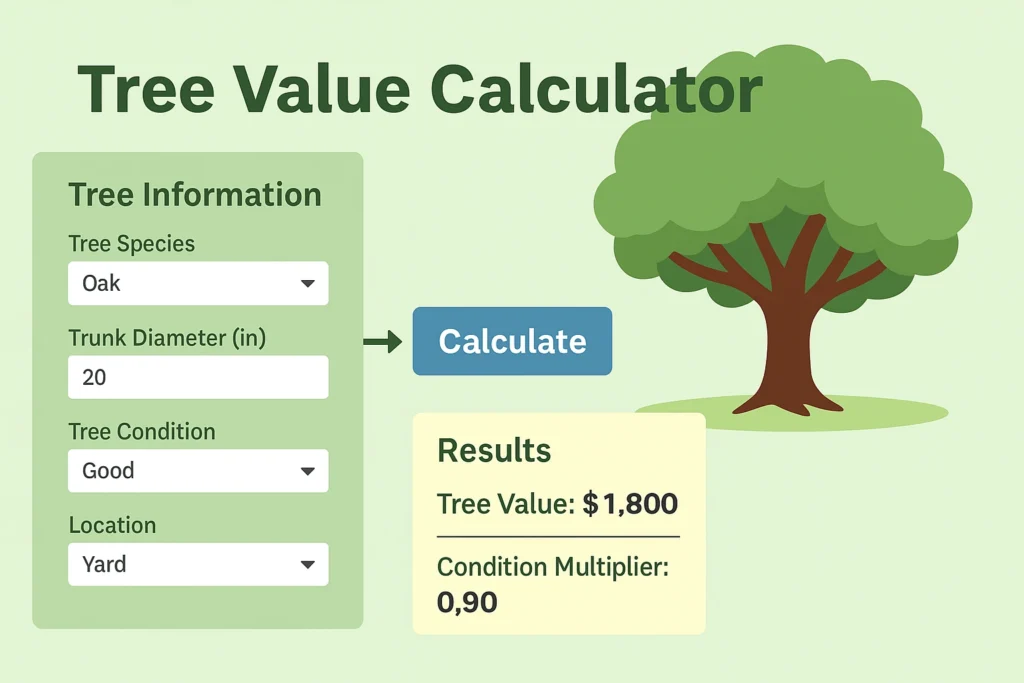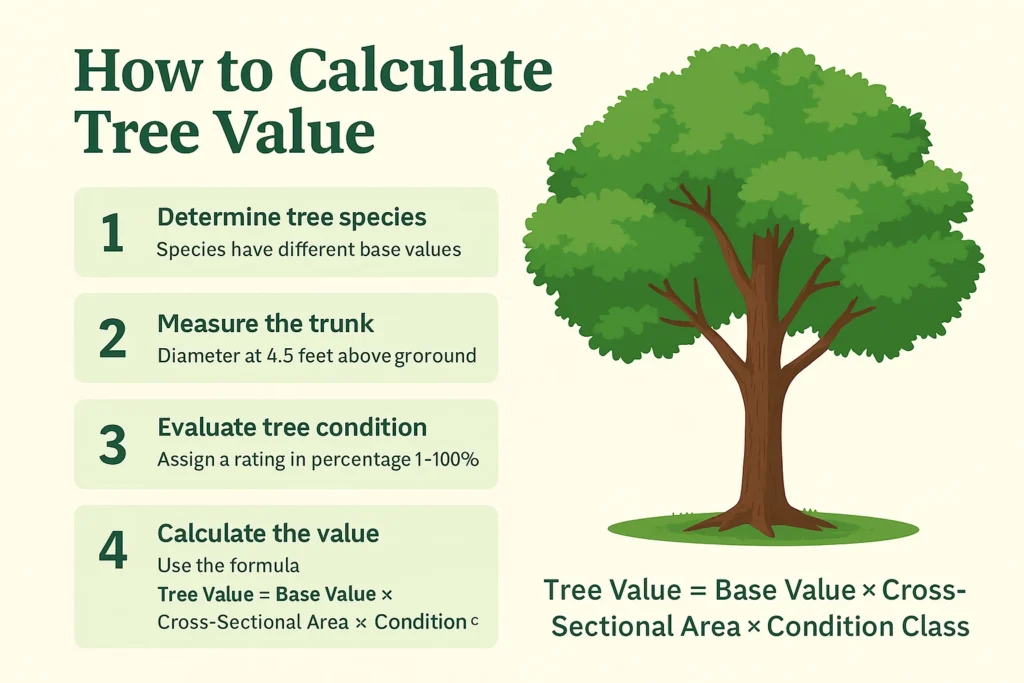These factors are multiplied with the base valuation to reflect real-world conditions. A healthy tree in a high-traffic area with minimal pests might be assigned higher multipliers.
Additional Factors Summary
Estimate the monetary value of your tree(s) using different valuation methods.
Valuation Results
These factors are multiplied with the base valuation to reflect real-world conditions. A healthy tree in a high-traffic area with minimal pests might be assigned higher multipliers.
Additional Factors Summary
Enter values for multiple trees, growth rate, or pests/disease to further refine your valuation.
Advanced Factors Summary

With a background in botany and ecological sciences, James specializes in creating practical tools and resources to help gardeners, farmers, and plant enthusiasts optimize their green spaces.
Have you ever wondered how much the trees in your yard—or on your property—are actually worth? Whether you’re curious for insurance purposes, considering a landscaping upgrade, or thinking about selling timber, using a tree value calculator is the most practical place to start.
But calculating tree value isn’t as straightforward as plugging in a number. Trees are living, growing assets. Their value is influenced by a surprising range of factors—some objective, some a bit subjective.
In this guide, we’ll walk you through how to estimate your tree’s value, what influences it most, how different tree species stack up, and when using a tree value calculator is truly accurate.

The primary tool you’ll need is a reliable tree value calculator—one that factors in species, size (typically DBH, or diameter at breast height), and condition.
Start with our Tree Value Calculator, which gives a baseline estimate based on standard formulas used in forestry and landscaping. The tool allows you to input your tree’s DBH and select species-specific values where applicable.
You might be surprised to learn that not all trees are valued for the same reasons. Black walnut, for instance, may fetch high prices in logging due to its dark hardwood, while an old oak could have much more value as a landscape centerpiece than as timber.
This leads us to a question people often ask: What is the real value of a tree? The answer varies—sometimes dramatically.
A tree value calculator considers three main variables:
Species – Some trees like black walnut, oak, or cedar hold higher commercial value.
Size (DBH) – The larger the trunk diameter, the more potential wood volume or aesthetic value.
Condition and Location – A perfectly symmetrical tree in a well-maintained yard will likely be appraised higher than a leaning, partially decayed one on a forest’s edge.
Location introduces some complexity. A pine tree in rural Texas may be worth very little as landscape ornamentation but could still fetch some value for timber. Conversely, the same pine in an upscale urban setting might have value purely due to its placement and visual impact.
That’s why some people prefer to use individual species calculators for more accurate estimates, such as:
Even if you’re not planning to cut or sell, using these tools gives insight into how species and site contribute to overall property value.
Sometimes, all you want is a simple chart. A tree value calculator does this automatically, but here’s a general idea:
12" DBH Tree: $1,000–$2,000
20" DBH Tree: $3,500+
Notes: High timber demand
12" DBH Tree: $600–$1,500
20" DBH Tree: $2,000+
Notes: Valuable for landscape
12" DBH Tree: $100–$400
20" DBH Tree: $600–$1,000
Notes: Common, fast-growing
12" DBH Tree: $500–$1,200
20" DBH Tree: $1,800+
Notes: Strong, durable wood
12" DBH Tree: $400–$1,000
20" DBH Tree: $1,500+
Notes: Aromatic wood, aesthetic use
Of course, these numbers are estimates—and even foresters disagree on them. That’s why using a proper calculator matters.
Here’s something counterintuitive: Sometimes, a tree is worth more standing than it is as timber. A mature oak shading your front yard could increase property value by thousands—especially in hot regions where cooling shade reduces energy bills.
But if you cut it down and sell it? You might get a few hundred bucks, tops.
This is why a tree value calculator should never be used in isolation. For landscaping, emotional, or legal reasons, a tree’s “value” goes beyond board feet. Still, tools like the oak tree value calculator or cedar value calculator can be useful benchmarks.

Want to do it manually—or at least understand what’s happening behind the scenes?
Measure DBH (Diameter at Breast Height, 4.5 ft above the ground). Use the Tree Diameter Calculator for accuracy.
Determine Tree Species – If unsure, check with a local arborist or use an app like iNaturalist.
Use Local Multipliers – Tree value can vary by region. Urban trees often use a higher per-inch multiplier than rural ones.
Apply Tree Health and Site Factors – Adjust value based on health, form, location, and risk.
Estimate Using a Calculator – This is where tools like the Tree Value Calculator shine.
While the science behind it is relatively fixed, human judgment is always part of tree valuation. Even two certified arborists may disagree by a few thousand dollars.For a deeper look at the professional criteria behind tree valuation, explore the tree appraisal methods used by certified arborists as outlined by the International Society of Arboriculture.
What is the value of a tree?
It depends—species, size, and condition are key, but location and purpose matter too. The same tree can be valued differently as a landscape element, timber resource, or environmental asset.
How much are trees worth for logging?
In general, timber trees like pine or black walnut can fetch $200–$5,000, but logging logistics, permits, and haulage often cut that down. The Black Walnut Calculator is helpful for this.
Can I sell a single tree from my yard?
Rarely, unless it’s a high-value species and easily accessible. Most logging companies won’t mobilize for one tree unless it’s exceptional.
Do tree value calculators include ecological or sentimental value?
No, they focus on tangible market value. For legal cases or insurance, emotional and ecological factors may be argued separately.
A tree value calculator is a helpful starting point—whether you’re managing a forest, planning to sell timber, or just curious about your landscape. While it’s not perfect, and the real-world value of trees remains partly subjective, tools like these create a solid baseline.
At the very least, they’ll make you think twice before cutting down that old oak in the backyard.
The Ultimate Tree Value Calculator provides estimates only. Actual tree values depend on market conditions, buyer interest, and other economic factors. For professional assessments, consult a certified arborist or forestry expert.
Discover Tree & Forestry Calculators
